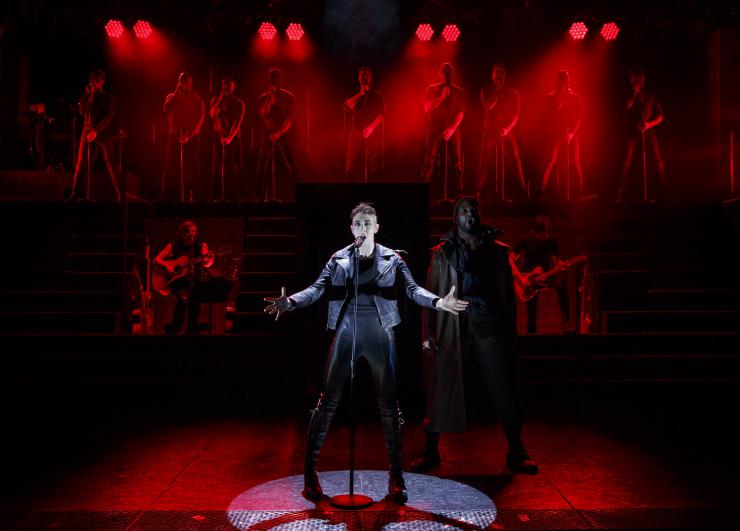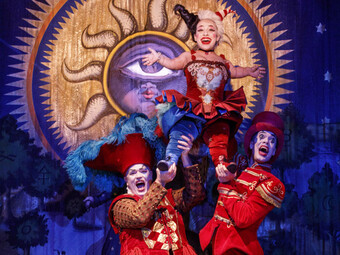The Power of Jo of Arc
It's 1429. The English control half of France, the dauphin is banished from his throne, the countryside is in ruins, and a seventeen-year-old girl is about to grip a microphone for the first time. She hesitates when the soldier sets the mic stand before her, but the pause is brief. Inspired by God, she grabs the mic, and becomes the rock star that Joan of Arc was always meant to be.
"I'm not a boy, and not a girl," she wails. "This is a prayer for everyone."
It is a loud, glittering play that refuses to dive deep into its hero's psyche, giving us anthems instead of ballads, and sweep instead of nuance. This is not a failure so much as it is a stark, understandable choice.
Written by David Byrne and directed by Alex Timbers, Joan of Arc: Into the Fire is a hard-driving rock musical that opened at the Public Theater on March 15, and is currently scheduled to run through April 30. Starring the brilliantly talented Jo Lampert as Joan, it is a loud, glittering play that refuses to dive deep into its hero's psyche, giving us anthems instead of ballads, and sweep instead of nuance. This is not a failure so much as it is a stark, understandable choice. Joan of Arc presents Joan the warrior, Joan the martyr, Joan the rock god. If we don't get to see Joan the person, that's okay, because we get Jo Lampert instead, and she is extraordinary.
When Joan of Arc, the real Joan of Arc, was on trial for her life, she was asked endlessly to describe the heavenly vision that sent her on her journey. She spoke of a kindly voice whose first message was simple, almost benign: "Be good," it said. "Go to church often." The voice was accompanied by "a great deal of light on all sides, as was most fitting." In telling Joan's story, Byrne and Timbers have no time for a message as banal as "Be good." But they bring a great deal of light, and it fits their story beautifully.

When Joan takes her place at the head of the French army, she is clad in what the lyrics describe as "armor of white," but is really a shimmering, mirrored doublet suitable for a disco queen. Lighting director Justin Townsend's lights bounce off Joan's costume, casting crazy patterns on the walls of the theatre and on the audience, and making it impossible to look away from her.
Not that it would be easy to look away from Lampert anyway. She is the only woman on a stage of men, the only actor in a form-fitting costume in a company clad in boxy military uniforms. Her voice is hypnotic, charging from a sibilant whisper to a defiant shout, and her face has a chameleon quality, shifting so drastically from the start of the play to the end that there were moments that I wondered if another actor had taken over the role.
You can get a sense of her charisma in this 2013 video of Lampert covering the Tom Waits song "Chocolate Jesus." She shows remarkable range, not just vocally but as an actor, in these 95 seconds, and she appears to be fighting to keep herself from standing up and strutting around. Joan of Arc is an incredible platform for Lampert's voice and energy, which make up for the fact that in the whole play, she never gets to sing anything as good as that Tom Waits song.
Rock opera is a term that's lost most of its meaning, but it's probably the best way to describe Joan of Arc, a 95-minute play which is sung nearly straight through. Thankfully, David Byrne knows rock, which means that none of the music has the watered down wimpy quality that "rock opera" usually implies. Unfortunately, with the notable exception of a brilliantly funny song about torture and a few moments of exquisite Mexican trumpet, Byrne's score begins to sound like a single long, forgettable song. Joan and Jo both deserve better.
Although there are a few moments that remind us of the horrible cost of Joan's campaigns, such as a beautiful scene when she walks down a staircase covered in the bodies of her fallen soldiers, this play is largely content to stay within the normal bounds of Joan's legend.
This was not the case with Here Lies Love, Byrne and Timbers' 2013 collaboration at the Public, where Byrne drew on a variety of genres to seduce the audience into falling in love with the dictatorship of Ferdinand and Imelda Marcos. By painting autocracy in bright, shiny colors, Here Lies Love forced the audience to reckon with how easy it can be to give yourself over to a dictatorship—a lesson more valuable in 2017 than it was four years ago. It was radical to portray Imelda Marcos as a hero. Less so with Joan of Arc.
Although there are a few moments that remind us of the horrible cost of Joan's campaigns, such as a beautiful scene when she walks down a staircase covered in the bodies of her fallen soldiers, this play is largely content to stay within the normal bounds of Joan's legend. She inspires the troops; she waves the flag; she dies for the glory of France. It is a classic story, and one well told, but there were moments when the play hinted that it might go deeper, and I wish it had.
Over the course of a year, Joan leads the French army to victory after victory, finally carrying the dauphin to the cathedral at Reims, where he is crowned king of France. When the dauphin (Kyle Selig) and his emo haircut were introduced, and sang, "I wonder if I am real. Who can teach me and guide me to lead and command?", I worried that Joan would take the backseat to him, another female warrior lost to Trinity Syndrome. Thankfully, that does not happen. The dauphin stays in the background, and even at his own coronation, Joan and her glittering armor upstage him.
(As an aside, would it have been so hard to cast a few more women in this play? Aside from Joan and her mother (Mare Winningham), who appears in one scene, every person on stage is a man. The other ten actors serve as a chorus, anonymous enough that the actor's gender shouldn't matter. Yes, those actors spend most of the play portraying soldiers, and no, the fifteenth century French army was not a coed affair. But the fifteenth-century French army also probably didn't sing this much, so realism has already gone out the window. It seems hypocritical for a play whose first image is a banner reading, "She was warned. She was given an explanation. But she persisted," to shy away from gender-blind casting.)

"I am God's messenger," Joan tells the king, demanding more troops that she might retake Paris, and the new king refuses, telling her, "Your work is done." But like the light skidding off her costume, Joan is impossible to control. She marches on Paris anyway, and when her attack fails she is captured. When the king refuses to pay her ransom, she is put on trial for heresy, and finally burned at the stake.
Her death is a truly shocking moment, and one of the best in the entire play. A soldier marches downstage carrying a lit torch and places it at her feet. The stage erupts in flames and fills with smoke. There is an explosion, the lights go out, and a spot, the same that earlier stood in for the voice of God, shines on the burnt wooden post where Joan died.
I saw Joan of Arc by myself, which may have been a good thing, since it's easier to look past a play's failings and appreciate its best parts when you aren't pressed to express your opinion as you walk out the door. There was something magical about walking home on a cold March night, and feeling like Jo Lampert's grace and fury had been presented just for me, as powerful a message as God delivered to Joan.








Comments
The article is just the start of the conversation—we want to know what you think about this subject, too! HowlRound is a space for knowledge-sharing, and we welcome spirited, thoughtful, and on-topic dialogue. Find our full comments policy here
This is an excellent review--I think you really hit the nail on the head vis-a-vis the problems with this production--and also the magic of it. Thanks!
https://uploads.disquscdn.c...
For those who might be interested in a stage telling of Joan's story with nuance, not glitter; about a young woman trying to come terms with a calling that is greater than her relationships with her sister, her father, her boyfriend, her confessor, and the other adults in her life, might I recommend Darrah Cloud's JOAN THE GIRL OF ARC (Dramatic Publishing). Commissioned and toured by Cincinnati Playhouse a few years ago, this decidedly non-spectacular, human-sized play depends on text and acting to tell a pretty moving, and often funny, stage story about a girl with a myth thrust upon her.